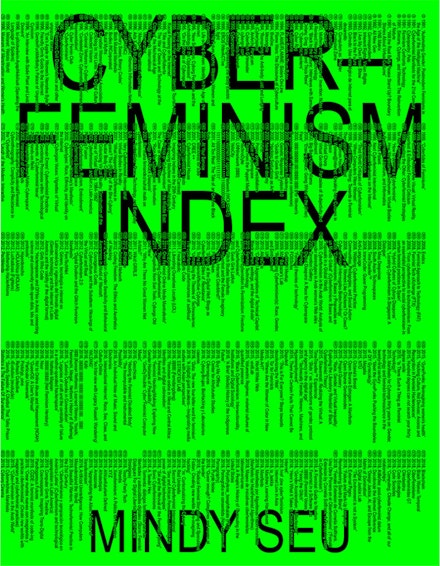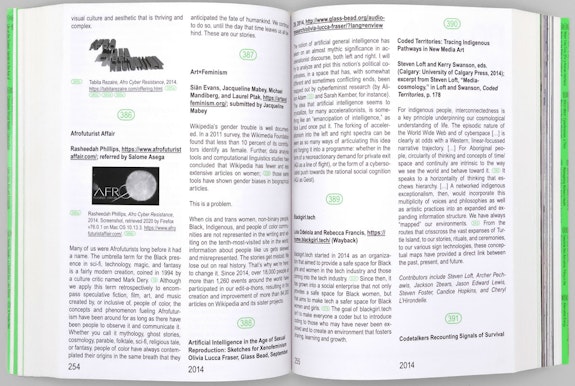Art Books
Mindy Seu’s Cyberfeminism Index
This book hacks the strictures of academia by challenging the perceived primacy of printed matter over identical open-source content.

Cyberfeminism Index
(Inventory Press, 2023)
The use of the term “cyberfeminism” can be traced back to 1991, the year some call the birth of the internet. Broadly speaking, it refers to a collection of emancipatory theories and practices that foster an alliance between feminists and technology. In March 2019, designer and researcher Mindy Seu tweeted, “I’m creating a cyberfeminist index,” and shared a link to a spreadsheet she hoped would become a site of collaboration. As the spreadsheet grew to nearly seven hundred rows—at a time when info-activism and open-access libraries proved crucial to consciousness-raising in the context of global exigencies like the pandemic and the Black Lives Matter protests—Seu used the data to create an easy-to-search website, cyberfeminismindex.com. In January 2023, Seu again repackaged the data as a book, Cyberfeminism Index, this time hacking the strictures of academia by challenging the perceived primacy of printed matter over identical open-source content.
Seu’s edited volume is divided into five sections: reading lists, annotated entries, source titles, prominent figures in the field, and images—which include screenshots, video stills, logos, and schematics. Flashy, neon, and nostalgic, the images draw the eye of the reader to the back of the book. The first is a double-page spread of Australian art collective VNS Matrix's “DNA Sluts,” three characters from an interactive CD game the group created in 1993. These characters resemble armored action figures. They face forward, baring genitalia from which white laser beams erupt (in the book’s afterword, curator Legacy Russell acknowledges the early cyberfeminists’ essentialist error in naming the clitoris “the direct line to the matrix”). Visual quotations are also taken from works like Old Boys Network’s Processing Cyberfeminism (1999), a 15-minute compilation of footage in which members of the Berlin-based alliance present their own definitions of cyberfeminism through tongue-in-cheek skits and poetic monologues, and Tabita Rezaire’s Afro Cyber Resistance (2014), an 18-minute video in which the artist speaks to the camera against a glitched digital backdrop, presenting research on the Internet’s built-in geographical biases. One after the other, the images fill their respective pages, often leaving room for neither captions nor explanatory text, glutting the reader with visuals as energizing as they are bewildering.

To try to read the index linearly in one sitting would be a mistake. The book does not elucidate the history of an idea so much as it suggests connections through juxtaposition. Entries are grouped by year, but within these groupings they are listed alphabetically, so it is up to the reader to piece together the shape of the discourse, often by turning back to the internet. The fourteen reading lists at the front of the book, curated by thinkers like Legacy Russell, Melanie Hoff, and Neema Githere, function less like guides than like class syllabi, outlining first steps with the expectation that the reader will veer off on their own.
In the annotated entries, the ethos of cyberfeminism is expressed through layers of mediation and reference. Writers embody the rhizomatic spirit of the project by quoting at length from one another’s contributions. As is the case with gossip, certain thinkers and collectives—Donna J. Haraway, Sadie Plant, VNS Matrix, Old Boys Network—make repeated appearances. As cyberfeminists name other cyberfeminists, pathways multiply, and the book thickens.
Cyberfeminism Index and cyberfeminismindex.com share a visual identity: the green glow of the “submit” button at the bottom of the website’s homepage is echoed in the color design of the Index’s cover and typographical symbols. When reading the book, one might crave the convenience of the website, its drop-down menu and search function. However, if attempting to access Seu’s database on public Wi-Fi, one might experience significant lag and, conversely, long for the book, wherein images are always already loaded. Like the online entries, those in the book are somewhat frustratingly truncated, but as an archive they illuminate patterns and change. Early entries sound quirky and bombastic to the contemporary ear, while more recent entries sound, in comparison, pellucid and sober, directed as they are toward audiences with some presumed knowledge of the discourse. The arc of the book subtly suggests ways in which discourse has grown and even outgrown itself. The final entry, by scholar Julia R. DeCook, calls for a critical reassessment of entry #1, Donna J. Haraway’s “A Cyborg Manifesto.” We must find ways to theorize cyborgs, writes DeCook, “without upholding whiteness and Western epistemology as the center.”
In her introduction, Seu insists that Cyberfeminism Index is, like its web-based predecessors, open to revision and collaboration. The 600-page tome, however, with its perfect binding and sleek design, exudes a sense of finality and authority, although of a different sort than the academic elitism Seu set out to hack. As a comprehensively intertextual, future-oriented archive, Seu’s book gains credibility precisely where it yields to the babel of contradictions thriving in the margins of cyberspace.

